Export data from reports
 Note: To optimize efficiency and security, support for XLS format has been deprecated, and instead, the XLSX format will be supported with effect from 21-March-2024. We insist you to replace any instance of .xls to .xlsx across Deluge scripts in your Creator applications.
Note: To optimize efficiency and security, support for XLS format has been deprecated, and instead, the XLSX format will be supported with effect from 21-March-2024. We insist you to replace any instance of .xls to .xlsx across Deluge scripts in your Creator applications.Exporting settings for subform/composite fields

- Subform field export: This applies to all report types exported in the XLSX format.
- Composite field export: This applies to all report types exported in CSV, JSON, TSV, XLSX and XML formats.
- Single column: Exports subform fields' data into one column within the same sheet with a delimiter.
- Separate columns: Exports subform fields' data into individual columns within the same sheet along with other columns.
- Separate sheet: Exports subform fields' data into individual columns in a new sheet.
- Single Column: Exports all sub-fields' data into one column within the same sheet with a delimiter.
- Separate Columns: Exports all sub-fields' data into individual columns within the same sheet along with other columns.

Salient Features
- You can export the data in the reports that you create using Zoho Creator.
- You can export your reports from the following places:
- reports in the live mode of your Creator application
- reports embedded inside your Creator pages
- published reports
- reports in the customer portal
- reports in your On-premise setup
- You can export them in various file formats such as XLSX, PDF, HTML, XML, JSON, CSV, and TSV.
- You can customize the data that you wish to export and also set passwords for sensitive data. Learn more
- After exporting, you can access them offline and email the reports to your users.
- Password protection for exported files
- Hiding columns while exporting files
- Steps to export records (XLSX, XML, JSON, CSV, and TSV formats)
- Steps to export records a PDF file
- Steps to export records as an HTML file
- Mobile and tablet implementation
- Limitations
Password protection
Passwords provide the first line of defense against unauthorized access to your personal information. The stronger your password, the more protected your data will be from hackers and malicious attacks. A strong password contains a mix of letters (upper and lower case), numbers, and symbols, and no ties to your personal information. Password protection enables you to protect your data by assigning it a strong password. Other users cannot read, change, or delete your data without knowing the password.
Hide columns
Hiding a column prevents the viewer from being able to view certain columns that you deem unnecessary. When you have hidden columns in your report, they will be displayed with a hidden tag in the columns listed in the Export popup.

Note:
- By default, hidden columns will be unchecked in the column listing. You can check them whenever required.
- When you export reports with hidden columns, the exported file will not contain the hidden columns and their values.
Steps to export records (XLSX, XML, JSON, CSV, and TSV formats)
- Navigate to the live mode of your app.
- Click on the hamburger icon at the top right corner of your screen and click Export.
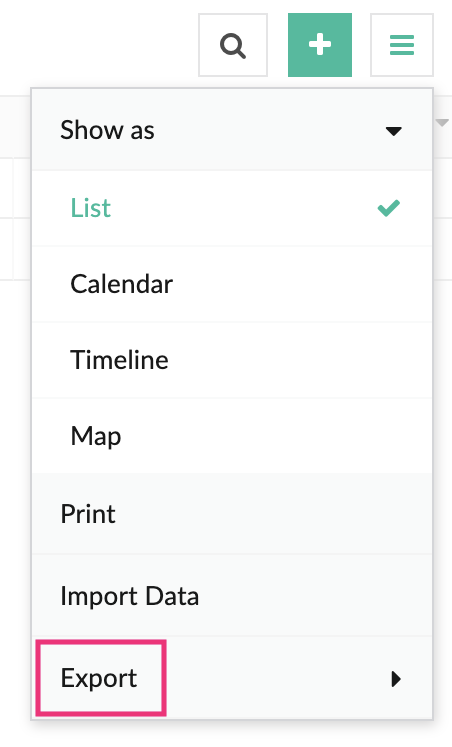
- Select the required format to export the records.
- If you choose either one of the following formats — XLSX, XML, JSON, CSV, and TSV, then proceed to the next step (4).
- If you choose PDF format, click here.
- In the Export popup, you can do the following:
- Edit the file name and change the export type as required.
- You can either select all columns by clicking the minus (-) icon at the topmost column or individually select the required fields.
- Click the filter icon at the top-right of the popup to select columns based on view types — Quick View and Detail View. You can also select the All Fields option from here.
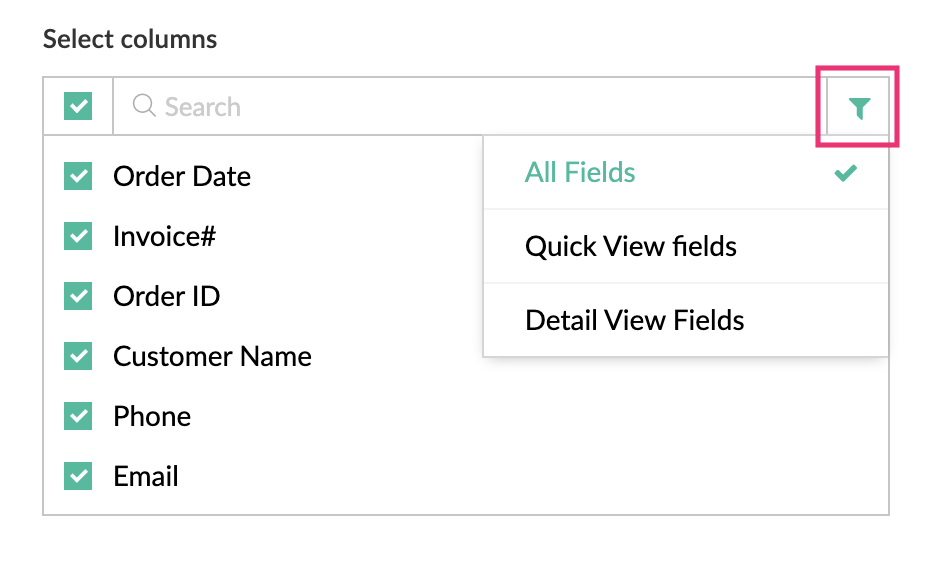

Note:
- When you select either Quick View fields or Detail View fields, only the fields corresponding to the chosen view will be displayed in the field column listing. You can unselect fields not required in the chosen view.
- When you choose the All Fields option, fields in both the views (Quick View and Detail View) will be displayed. You can select or unselect fields in the field column listing.
- You can also search the required column (field) name in the search bar at the top and select them.
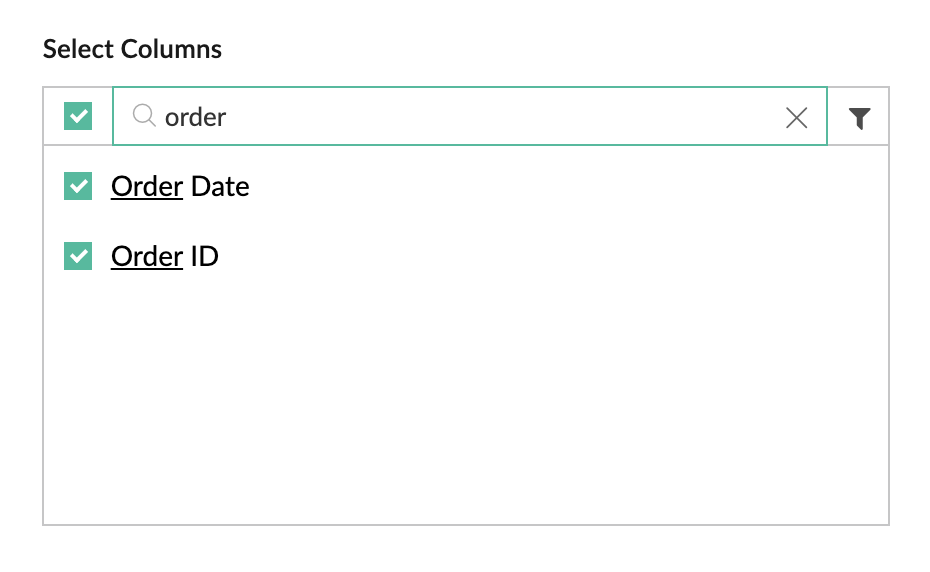
- To secure your data outside of Creator, you can enable password protection for the exported files. Select the checkbox beside Require password to open and specify a strong password.
 Note: A strong password contains a mix of letters (upper and lower case), numbers, and symbols, no ties to your personal information, and no dictionary words. We strongly recommend you to use password protection for records that store sensitive PII (Personally identifiable information) and ePHI (Electronic protected health information) data.
Note: A strong password contains a mix of letters (upper and lower case), numbers, and symbols, no ties to your personal information, and no dictionary words. We strongly recommend you to use password protection for records that store sensitive PII (Personally identifiable information) and ePHI (Electronic protected health information) data.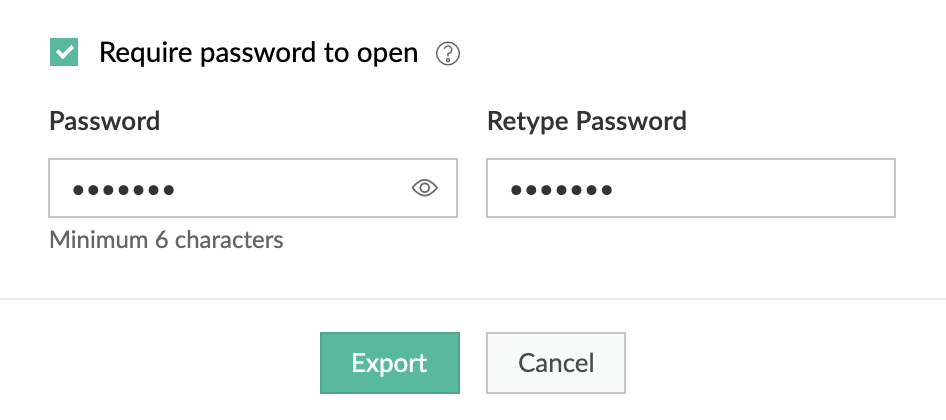
- Click Export. Your file will be downloaded in the chosen format.
- You need to type in your password before opening your exported file (if password protection is enabled).


Steps to export records as a PDF
- Navigate to the live mode of your app.
- Click on the hamburger icon at the top right corner of your screen and click Export.
- Select the PDF option under the Export as dropdown.
- In the Export popup, you can do the following:
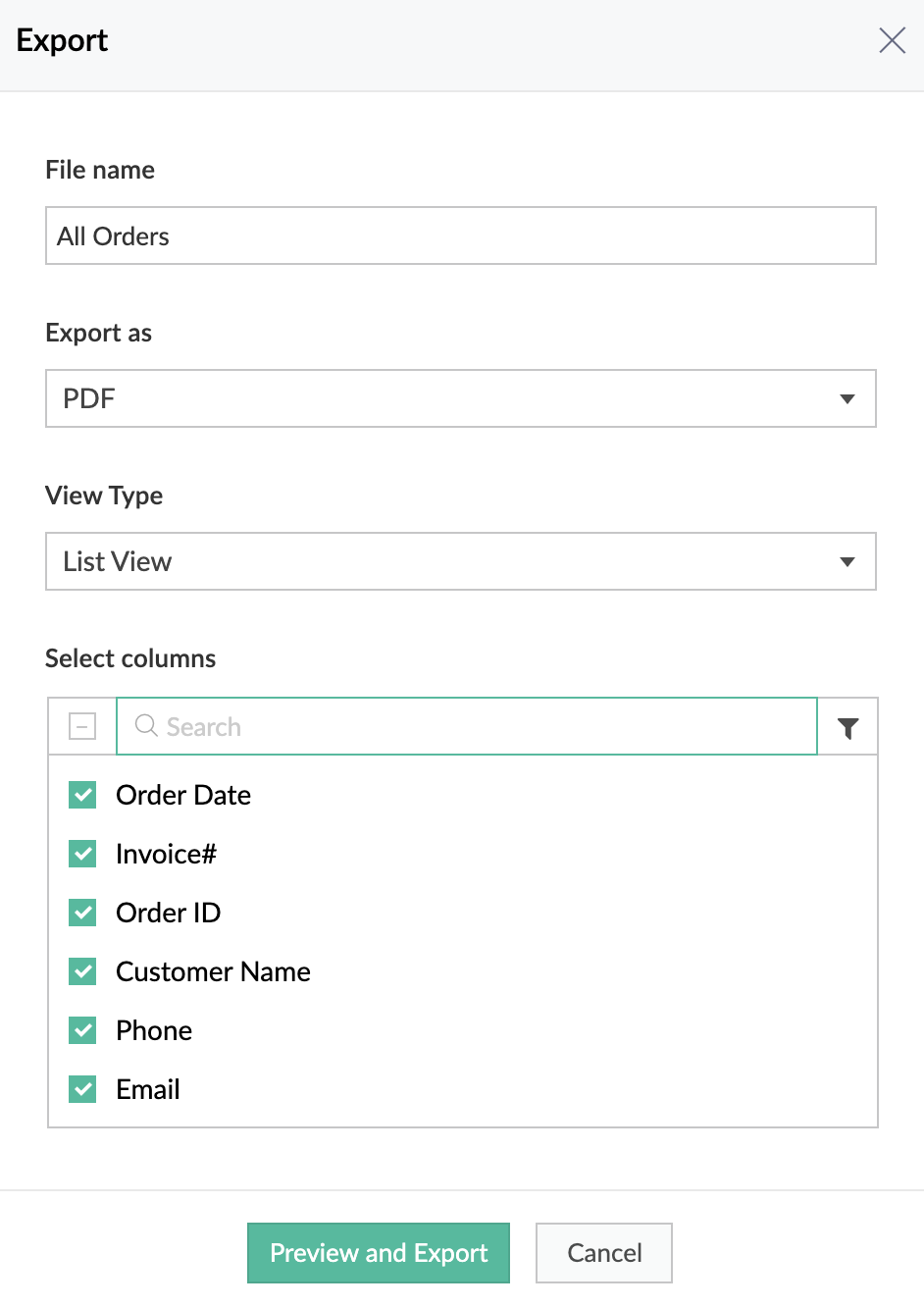
- Edit the file name and select the view type as required:
- List view: The records will be exported in a table-like format as shown in the current view, where the field labels are in the header row and the records are listed in the subsequent rows similar to the Quick view in reports.
- Summary view: The records will be exported in a layout that enables you to see the detailed view of the record in a linear manner. You will be able to see all the fields and their congruent as label and value pairs. If you select the Summary view option, proceed to step 8 (you will not be able to select the required columns in this option).
 Note: If you have configured a record template for your report and when the summary view option is selected, then the record template will be exported as the detailed (summary) view of each record in your report.
Note: If you have configured a record template for your report and when the summary view option is selected, then the record template will be exported as the detailed (summary) view of each record in your report.
- You can either select all columns by clicking the minus (-) icon at the topmost column or individually select the required fields.
- Click the filter icon at the top-right of the popup to select columns based on view types — Quick View and Detail View. You can also select the All Fields option from here.
- You can also search the required column (field) name in the search bar at the top and select them.
- Once you have made the required changes, click the Preview and Export button. The Export Settings preview will open.
 Note: The page setup options chosen in your record template will be pre-filled in the Export Settings tab.
Note: The page setup options chosen in your record template will be pre-filled in the Export Settings tab.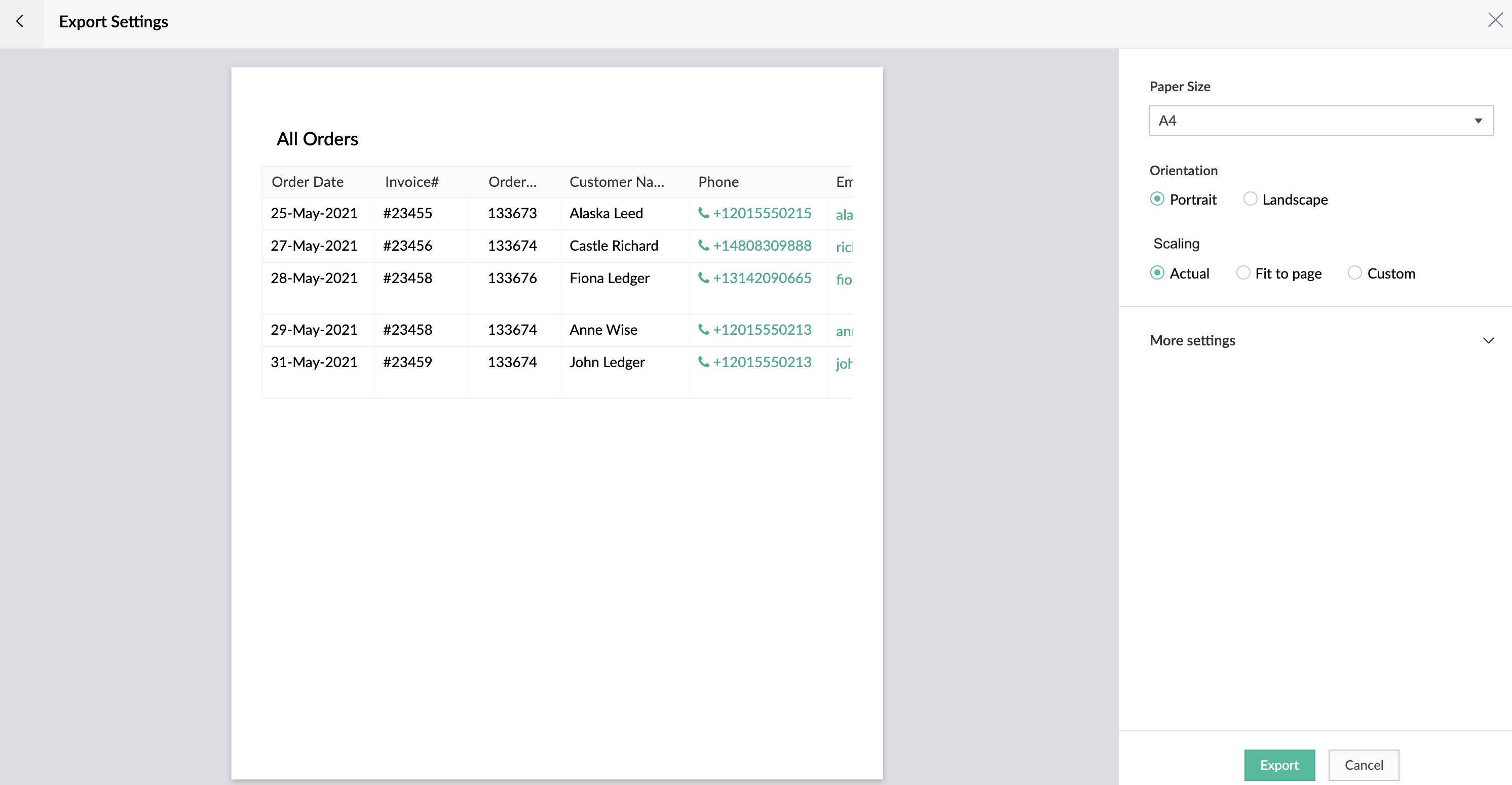
- Select the paper size and orientation (Portrait or Landscape) as required.
- Choose the required scaling:
- Actual width - This option will print the columns/field-value pairs with their actual width in live mode onto the selected paper size. There might be instances where some columns might be cut off after export.
- Fit to page width - This option will shrink all columns to the selected paper size. In case you have chosen Detail view, this option will not display any visible changes since there will be only two columns (records are shown as label and value pairs in Detail View).
- If the Custom option is chosen, you must select the required scaling value (%). This option helps to zoom out the entire report and print all the columns with proper readable width onto the selected paper size.
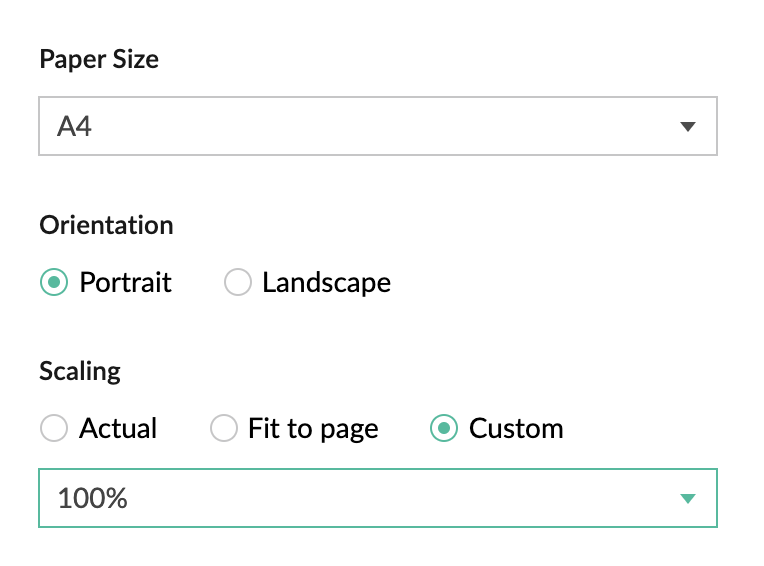
- Click the arrow beside More settings to specify the following:
- Margin: Specify the margin values for all four corners — top, right, bottom, and left.
- Header: Specify the fields (report name, date and time, and page number) to be displayed in the left, center, and right sides of your PDF file in the header. The report name can be customized to suit your requirements.
- Footer: Specify the fields (report name, date and time, and page number) to be displayed in the left, center, and right sides of your PDF file in the footer. The report name can be customized to suit your requirements.
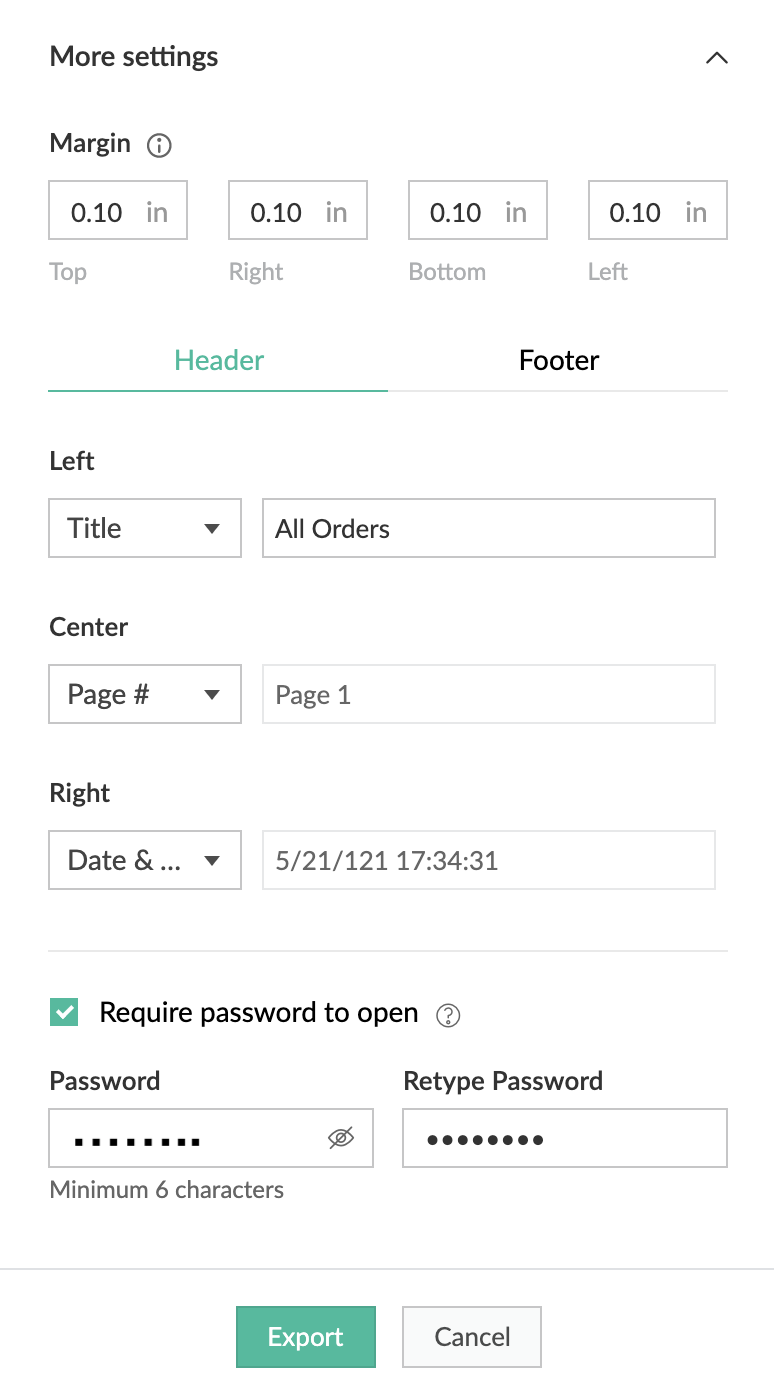
- To secure your data outside of Creator, you can enable password protection for the exported files. Select the checkbox beside Require password to open and specify a strong password.
 Note: A strong password contains a mix of letters (upper and lower case), numbers, and symbols, no ties to your personal information, and no dictionary words. We strongly recommend you to use password protection for records that store sensitive PII (Personally identifiable information) and ePHI (Electronic protected health information) data.
Note: A strong password contains a mix of letters (upper and lower case), numbers, and symbols, no ties to your personal information, and no dictionary words. We strongly recommend you to use password protection for records that store sensitive PII (Personally identifiable information) and ePHI (Electronic protected health information) data.
- Click Export. Your file will be downloaded in the chosen format.
- You need to type in your password before opening your exported file (if password protection is enabled).
Steps to export records as an HTML file
- Navigate to the live mode of your app.
- Click on the hamburger icon at the top right corner of your screen and click Export.
- Select the HTML option under the Export as dropdown.
- In the Export popup, you can do the following:
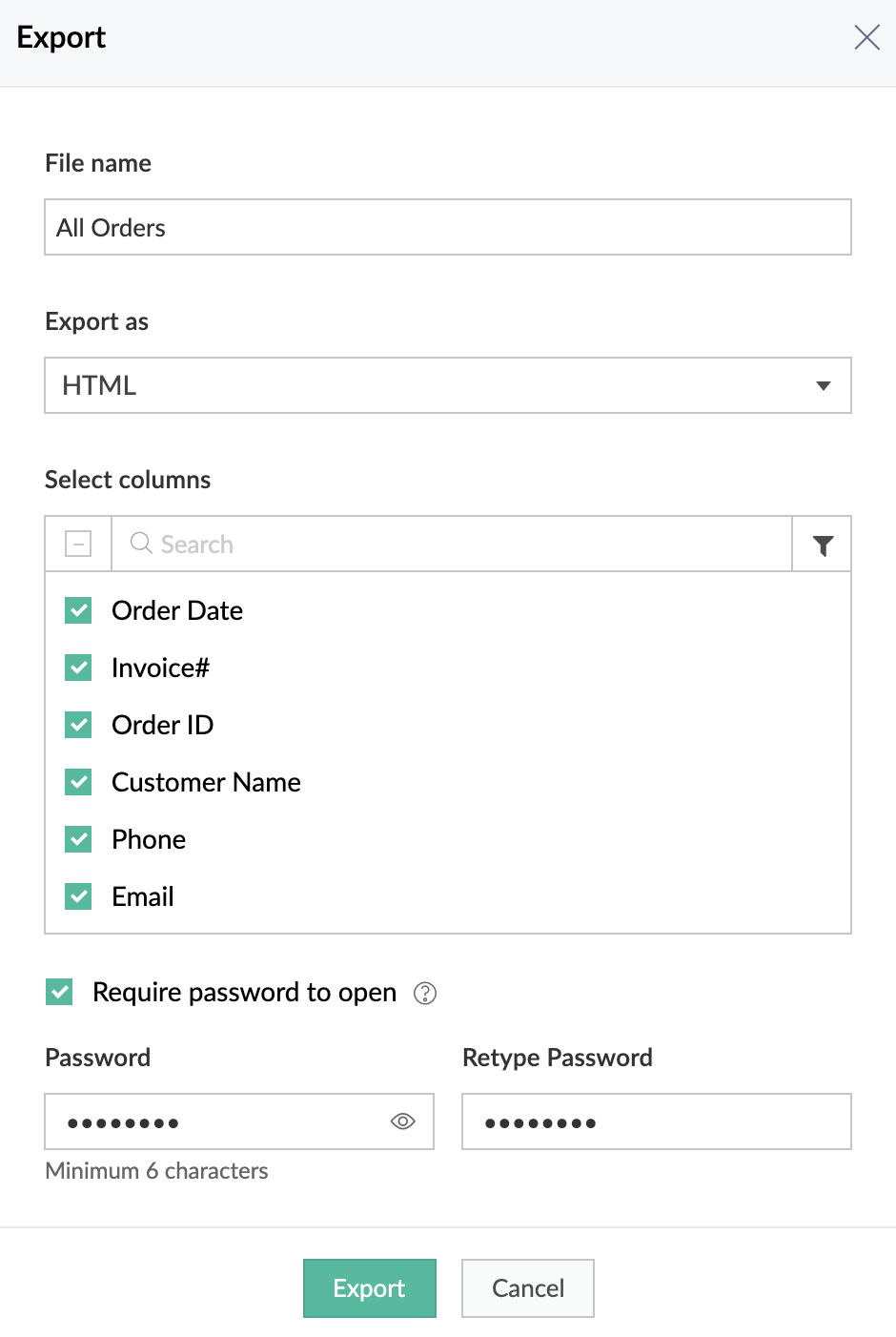
- Edit the file name as required.
- You can either select all columns by clicking the minus (-) icon at the topmost column or individually select the required fields.
- Click the filter icon at the top-right of the popup to select columns based on view types — Quick View and Detail View. You can also select the All Fields option from here.
- You can also search the required column (field) name in the search bar at the top and select them.
- To secure your data outside of Creator, you can enable password protection for the exported files. Select the checkbox beside Require password to open and specify a strong password.
 Note: A strong password contains a mix of letters (upper and lower case), numbers, and symbols, no ties to your personal information, and no dictionary words. We strongly recommend you to use password protection for records that store sensitive PII (Personally identifiable information) and ePHI (Electronic protected health information) data.
Note: A strong password contains a mix of letters (upper and lower case), numbers, and symbols, no ties to your personal information, and no dictionary words. We strongly recommend you to use password protection for records that store sensitive PII (Personally identifiable information) and ePHI (Electronic protected health information) data.
- Click Export. Your file will be downloaded in the chosen format.
- You need to type in your password before opening your exported file (if password protection is enabled).
Limitations
The following limitations are applicable to all report types.
- Only those users with export permissions will be able to export the report data.
- Custom actions configured in your reports will not be exported.
- There's a 12 MB limit on PDFs in the following scenario: When the report is exported as PDF and the data’s size exceeds 12 MB, the operation will fail and a 0 MB sized file will be downloaded instead.
- In HTML file export, media fields will not be exported. Also, in order to prevent the building UI from impacting the performance, you will be limited to export 50,000 records.
- In XLSX file export, the size of the file will be upto 150 MB for existing users and upto 70 MB for new users.
Related Topics
Zoho CRM Training Programs
Learn how to use the best tools for sales force automation and better customer engagement from Zoho's implementation specialists.
Zoho DataPrep Personalized Demo
If you'd like a personalized walk-through of our data preparation tool, please request a demo and we'll be happy to show you how to get the best out of Zoho DataPrep.
You are currently viewing the help pages of Qntrl’s earlier version. Click here to view our latest version—Qntrl 3.0's help articles.
Zoho Sheet Resources
Zoho Forms Resources
Zoho Sign Resources
Zoho TeamInbox Resources
Related Articles
Understand reports
Note: To optimize efficiency and security, support for XLS format has been deprecated, and instead, the XLSX format will be supported with effect from 21-March-2024. We insist you to replace any instance of .xls to .xlsx across Deluge scripts in your ...Understanding reports in a page
Embedding reports inside the page makes it easier for the user to monitor and analyze their business data and derive meaningful insights straight from the dashboard. It saves the effort of having to leave the page, navigate to a report from the same ...Import data to reports
Zoho Creator allows you to import data from into the reports in your Creator application. Creator supports importing data from .xls, .xlsx, .xlsm, .csv, .tsv, .ods, .accdb, .mdb, .json and numbers file formats. The required file can either be stored ...Export records
This API service lets you manage the different functionalities in a report. Export records Methods exportReport(for reportInfo: ReportInfo,withOption option:ReportExportAPI.ActionType, reportConfig: ReportAPIConfiguration, exportConfig: ...Style-based URLs for embedded forms and reports
In this topic we list out the parameters used in customizing the look and feel of Zoho Creator forms and reports. These parameters can be applied to the Forms and Reports embedded in your Pages. Form properties Description Parameter/Value Display ...















